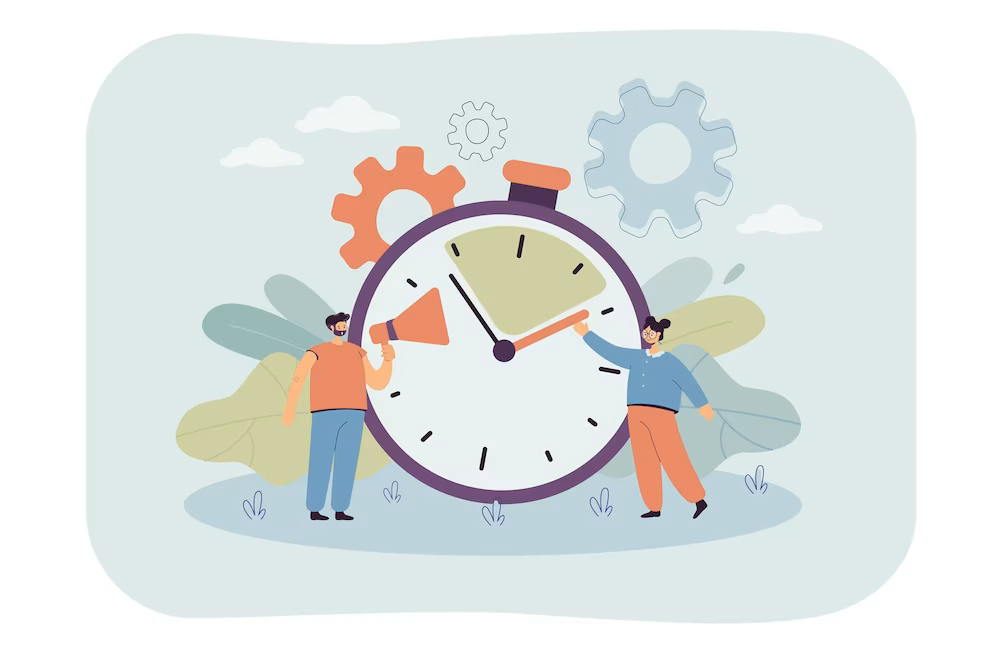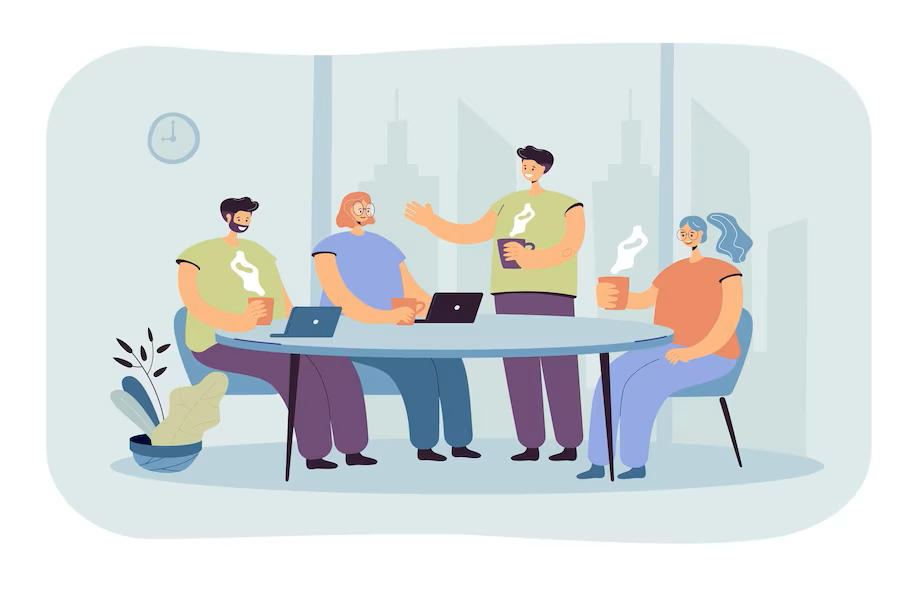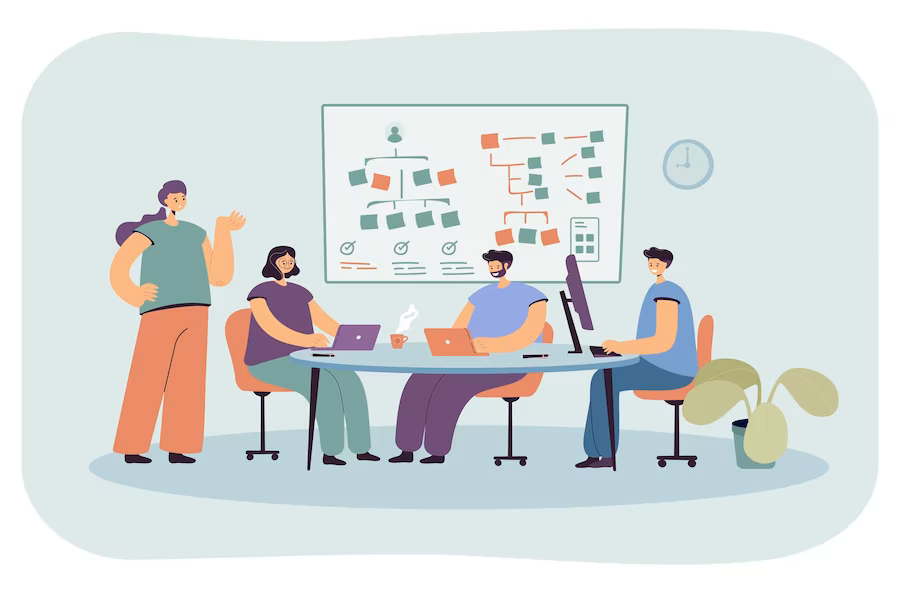.png)
You may juggle various roles, tasks, and responsibilities daily, making it challenging to achieve a healthy work-life balance. However, work-life balance is not a myth—it’s a tangible goal you can reach with the right strategies and tools. Balancing your professional and personal life allows you to maintain mental and physical health, reduces stress levels, and enhances overall happiness and satisfaction. And it all begins with daily planning.
Daily planning is a powerful tool for maintaining a healthy work-life balance. It allows you to organize your day, prioritize tasks, set boundaries, and ensure you’re spending quality time at work and with your loved ones. Daily planning helps you navigate your daily life in a balanced manner, reducing the risk of burnout while improving productivity and personal happiness. So, let’s get started!
1. Establish Clear Goals
.png)
Establishing clear goals is a crucial first step towards achieving a balanced life. Goals give us a sense of direction and form the backbone of our daily plans. When we set goals, we create a roadmap for our life that can guide us in making decisions and prioritizing tasks.
Actionable Steps
- Write your goals in a journal or digital platform, such as a reliable daily planner.
- Ensure your goals are SMART - Specific, Measurable, Achievable, Relevant, and Time-bound.
- Break down bigger goals into smaller, more manageable tasks.
- Review and update your goals periodically to ensure they align with your evolving priorities and aspirations.
Benefits
Setting clear goals helps you focus your energy on what truly matters, boosting productivity. It also brings a sense of purpose and motivation, positively impacting your mental health. Furthermore, clear goals can help you better manage your time, reducing stress levels and promoting a healthier work-life balance.
Difficulty Level: Easy
Implementing this strategy is relatively easy as it primarily requires introspection and a commitment to growth. However, sticking to your goals amidst various distractions and obstacles is the challenge.
2. Prioritize Tasks
.png)
Not all tasks are created equal. Some tasks have a more significant impact on achieving our goals than others. Therefore, learning to prioritize tasks is critical in managing your professional life and personal time.
Actionable Steps
- List down all the tasks you need to do.
- Evaluate the importance and urgency of each task using the Eisenhower Matrix, which divides tasks into four categories: essential and urgent, important but not urgent, not important but urgent, and not necessary or urgent.
- Focus on completing the essential and urgent tasks first, followed by those that are important but not urgent.
Benefits
Prioritizing tasks can save a significant amount of time and energy, thereby reducing your daily stress. In addition, it ensures you are spending time on the tasks that directly contribute to your goals, thereby facilitating better work-life harmony.
Difficulty Level: Moderate
While task prioritization is straightforward, its execution can be challenging. It requires objective evaluation and strategic decision-making skills. However, with practice and patience, it can become second nature.
3. Time Blocking

Time blocking is a time management method that divides your day into blocks of time, each dedicated to a specific task or activity. This method can be beneficial in maintaining a balanced lifestyle.
Actionable Steps
- Determine your most productive hours in the day.
- Schedule your most important and demanding tasks during these hours.
- Allocate specific time blocks for breaks, leisure activities, and personal time.
Benefits
Time blocking can significantly boost your productivity as it helps you avoid multitasking and focus solely on the task. Moreover, ensuring dedicated time for personal activities and breaks helps maintain a balanced lifestyle, enhancing your mental health and personal happiness.
Difficulty Level: Moderate
Implementing time blocking requires discipline and a commitment to adhering to the schedule. It may be initially challenging, primarily if you’re used to multitasking or unforeseen events that often disrupt your day. However, it can transform your productivity and work-life balance once you get the hang of it.
4. Set Work-Life Boundaries
.png)
Setting boundaries between work and personal life is essential to achieving a healthy work-life balance. Unfortunately, work can seep into your time without clear boundaries, causing stress and negatively impacting your relationships and personal well-being. The challenges of setting boundaries in modern life are compounded by the fast pace and unpredictability of daily living, making it even more crucial to establish clear limits.
Actionable Steps
- Set specific start and finish times for work.
- Create a physical or mental separation between your workspace and living space.
- Set rules about not checking work emails or messages during your time.
- Communicate your boundaries clearly with your colleagues and family.
Benefits
Establishing work-life boundaries helps preserve your time for relaxation, hobbies, and time with family and friends. It reduces the risk of burnout and supports mental health by providing time for leisure activities and rest. In our hyper-connected world, it is crucial to unplug regularly from electronic devices and social media to practice mindfulness and enhance mental well-being.
Difficulty Level: Moderate
Setting boundaries can be challenging, primarily if you work from home or have a demanding job. However, with clear communication and self-discipline, it can be effectively implemented.
5. Utilize Digital Tools
.png)
In today’s digital age, numerous apps and software can help manage your tasks, reminders, schedules, and even downtime. These digital tools can significantly enhance your daily planning and work-life balance.
Actionable Steps
- Use project management tools for tracking your professional tasks.
- Use calendar apps for scheduling and reminders.
- Use wellness apps for meditation, exercise, or tracking sleep patterns.
- Leverage automation tools to handle repetitive tasks.
Benefits
Digital tools streamline your tasks and save time, allowing you to focus on your core work and personal activities. As a result, they can boost productivity, keep you organized, reduce stress, and contribute significantly to a balanced lifestyle.
Difficulty Level: Easy
With many user-friendly digital tools available, incorporating them into your daily routine is relatively easy. However, learning and adapting to these tools requires an initial investment of time.
6. Regular Breaks

Taking regular breaks is vital for maintaining your mental health and productivity. Despite the misconception that breaks are a waste of time, scientific evidence suggests they are essential to maintaining a healthy work-life balance.
Actionable Steps
- Follow the Pomodoro Technique: work for 25 minutes, then take a 5-minute break.
- Get up and move during your break to stretch and refresh.
- Take longer breaks after completing more demanding tasks.
- Use your breaks to do something you enjoy, like reading or listening to music.
- Incorporate deep breathing exercises during breaks to relax and reduce stress.
Benefits
Regular breaks can help you feel balanced, prevent burnout, improve focus, and boost productivity. They also provide an opportunity for leisure activities, contributing to a healthier work-life balance.
Difficulty Level: Easy
Implementing regular breaks into your routine is easy. Still, it requires self-discipline to stick to the break schedule and not overextend work periods.
7. Regular Breaks for Mental Healtht

Your work environment significantly impacts productivity, stress, and work-life harmony. A well-optimized workspace can boost your efficiency and create a clear distinction between your professional and personal life.
Actionable Steps
- Keep your workspace clean and clutter-free.
- Set up a comfortable chair and desk.
- Ensure good lighting and ventilation.
- Keep necessary equipment and supplies within reach.
- Separate your workspace from your living space.
Benefits
An optimized work environment increases focus, productivity, and work satisfaction. It also helps establish a physical boundary between work and leisure time, contributing to a healthier work-life balance.
Difficulty Level: Easy
Creating an efficient work environment is relatively straightforward. Setting up and maintaining requires some initial effort, but the benefits far outweigh the effort.
8. Plan for Personal Development
.png)
Personal development planning is as essential as professional development for a balanced lifestyle. It involves setting goals for your health, relationships, hobbies, and other aspects of life outside work.
Actionable Steps
- Set clear and achievable personal goals.
- Break down your goals into small, manageable tasks.
- Prioritize these tasks and include them in your daily or weekly schedule.
- Regularly review and update your goals.
Benefits
Personal development planning helps you grow as an individual. It ensures you give time to your interests and relationships, contributing to a satisfying life outside work. Moreover, achieving personal goals boosts confidence and happiness, indirectly improving your work performance.
Difficulty Level: Moderate
Balancing personal development with professional commitments can be challenging. However, good planning and prioritization make it feasible and beneficial in the long run.
9. Include Time for Reflection
.png)
Finding balance in your day or week is a powerful tool for maintaining work-life balance. It allows you to assess your progress, identify areas for improvement, and make necessary adjustments to your plans and goals.
Actionable Steps
- Schedule a specific time each day or week for reflection.
- Review your completed tasks and achieved goals.
- Identify what worked well and what needs improvement.
- Adjust your plans and goals based on your reflections.
Benefits
Regular reflection helps you stay on track with your goals and maintain a balanced lifestyle. It provides insights into your work patterns and lifestyle, enabling you to make informed decisions and changes. Reflection also enhances self-awareness and mindfulness, supporting your mental health and contributing to a more balanced life.
Difficulty Level: Easy
While it might seem time-consuming initially, reflection becomes a natural part of your routine once you make it a habit. It doesn’t require special tools or skills, just some quiet time and honesty with yourself.
10. Manage Your Energy, Not Just Your Time

While time management is crucial, energy management is essential for maintaining a healthy work-life balance. Being aware of your energy levels and planning tasks accordingly can increase your productivity and overall satisfaction in your professional and personal life.
Actionable Steps
- Identify your peak energy hours and schedule demanding tasks for those times.
- Incorporate regular exercise into your routine to boost energy levels.
- Prioritize adequate sleep and good nutrition to maintain optimal energy.
- Take breaks and engage in leisure activities to recharge.
Benefits
You can maximize productivity and avoid burnout by aligning your tasks with your energy levels. In addition, this approach ensures you have energy for both work and personal activities, contributing to a balanced lifestyle.
Difficulty Level: Moderate
While it may take some time to identify your energy patterns and adjust your schedule accordingly, the benefits of improved productivity and reduced stress make it worth the effort.
11. Delegate Tasks

Delegating tasks, when possible, is a crucial skill for achieving work-life balance. Sharing responsibilities can free up your time for high-priority tasks and personal activities, whether at work or home.
Actionable Steps
- Identify tasks that can be delegated at work and home.
- Choose capable individuals to delegate to and communicate expectations.
- Provide necessary training or guidance.
- Trust others to perform the task and avoid micromanaging.
Benefits
Delegating reduces your workload and stress levels, allowing you to focus on tasks that require your unique expertise or attention. It also provides opportunities for others to learn and grow, promoting a positive work or home environment.
Difficulty Level: Moderate to Hard
Delegation requires trust, communication skills, and letting go of control. These can be challenging to develop, but they are essential for maintaining a healthy work-life balance.
12. Embrace Flexibility

Flexibility in your daily planning can significantly enhance work-life balance. It allows you to adjust your schedule according to your needs, unexpected events, or changing priorities.
Actionable Steps
- Create a daily or weekly plan but allow room for adjustments.
- Negotiate flexible working hours if your job allows it.
- Be open to changes and willing to rearrange tasks as needed.
- Avoid over-scheduling your day to allow for unexpected events.
Benefits
Flexibility reduces stress associated with strict schedules and unforeseen changes. It allows you to accommodate personal activities, fostering a balanced lifestyle. Additionally, it can improve job satisfaction, productivity, and personal happiness.
Difficulty Level: Easy to Moderate
The difficulty level depends on your personality, job constraints, and family responsibilities. While some people may find it easy to adapt, others may struggle. However, with practice, flexibility becomes more effortless and can significantly improve work-life balance.
13. Nurture Relationships
.png)
Maintaining solid interpersonal relationships is critical to work-life balance. It enhances personal happiness and builds a support system that can help you manage stress and maintain a balanced life.
Actionable Steps
- Schedule quality time with family and friends.
- Communicate openly about your needs and listen to theirs.
- Show appreciation and celebrate shared moments.
- Foster professional relationships that offer mentorship and support.
Benefits
Nurturing relationships can lead to emotional satisfaction, reduced stress, and improved mental health. It also creates a sense of belonging and mutual support that can help you navigate professional and personal challenges.
Difficulty Level: Moderate to Hard
Balancing relationship commitments with work demands can be tricky, but it’s vital for overall well-being and life satisfaction. It requires constant effort, empathy, and communication skills.
14. Include ‘Me Time’
.png)
Setting aside time for self-care and personal interests is essential in maintaining a healthy work-life balance. “Me Time” allows you to relax, rejuvenate, and engage in activities you love.
Actionable Steps
- Dedicate a part of your daily schedule to activities that you enjoy.
- Engage in relaxation techniques like meditation or yoga.
- Pursue hobbies or interests.
- Practice self-care routines for physical and mental health.
Benefits
Incorporating ‘Me Time’ in your daily plan promotes relaxation, reduces stress, and enhances overall well-being. In addition, it boosts creativity and productivity and leads to a more fulfilling personal life.
Difficulty Level: Easy to Moderate
While finding time for yourself amidst a busy schedule might seem challenging, it’s crucial for your mental health and work-life balance. Moreover, with good planning, it’s feasible.
15. Plan for Contingencies
.png)
Unexpected events or emergencies can disrupt your schedule and stress levels. Hence, planning for contingencies is vital for maintaining a steady work-life balance.
Actionable Steps
- Create a buffer in your schedule for unexpected tasks.
- Have a backup plan for essential tasks.
- Keep a list of tasks that can be postponed or cancelled.
- Maintain a healthy lifestyle to prepare for health-related contingencies.
Benefits
Planning for contingencies helps manage stress during unforeseen circumstances. It allows you to maintain productivity and balance despite disrupting your routine.
Difficulty Level: Moderate
While you cannot predict every possible disruption, developing a general strategy for handling unexpected events can make it easier to navigate them when they occur.
16. Plan for Contingencies and Unexpected Events
.png)
Outsourcing non-essential tasks can free up time for crucial work tasks and personal activities, enhancing work-life balance.
Actionable Steps
- Identify tasks that are time-consuming but don’t necessarily require your expertise.
- Research reliable services or individuals who can take up these tasks.
- Establish clear communication and expectations.
- Allocate saved time to high-priority tasks or personal activities.
Benefits
Outsourcing non-essential tasks can significantly reduce your workload, enabling you to focus on high-value tasks and personal interests. This results in increased productivity and a more balanced lifestyle.
Difficulty Level: Easy to Moderate
The initial effort in finding reliable resources and setting up a workflow may require time and patience. However, the time and stress saved in the long run make this strategy worth considering.
Integrating these strategies into your daily planning can significantly improve your work-life balance. But remember, maintaining a work-life balance is a continuous process that requires regular assessment and adjustment. As you journey towards a balanced life, stay flexible and patient, and celebrate every progress. Start today with Week Plan to create, manage and implement these strategies.
Conclusion
Achieving a work-life balance is not a one-time achievement but a journey filled with constant adjustments and reassessments. However, daily planning can bring harmony to our professional and personal lives, leading to enhanced productivity, improved mental health, and overall life satisfaction.
As we have explored, there are numerous strategies you can adopt. As you implement these strategies, Week Plan is here to help you every step of the way. This comprehensive tool can facilitate your daily planning, assist in setting clear goals, prioritize tasks, manage your energy, and much more. With Week Plan, you can take control of your schedule, ensuring your work-life balance doesn’t veer off the rails.
So, why wait? Start your journey towards a healthier work-life balance today!

More Posts
Habit 3 of Stephen Covey: Put First Things First
Put First Things First — Mastering the 3rd Habit
12 Ways Overthinking Contributes to Procrastination
Procrastination affects about 20% to 25% of adults. It leads to bad sleep, less exercise, and feeling alone. Overthinking is a big reason why people put things off. By knowing how overthinking stops us from finishing tasks, we...
10 Ways to Boost Productivity with Time Chunking
In today's fast-paced work world, getting a lot done is hard. Trying to do many things at once can make you tired and less efficient. But, time chunking can really help. It means...
10 Ways to Implement Continuous Improvement in the Workplace
It's key for any business to focus on getting better. This helps make the workplace more efficient and encourages new ideas. By making things better, companies can make customers happier and do better...